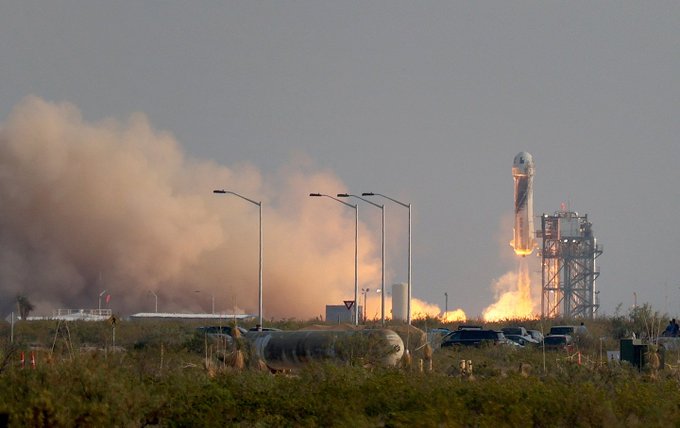Billionaires in Space
By A.M. Gittlitz
“Welcome to the dawn of a new space age,” said billionaire Richard Branson after the successful launch and landing of his spaceship the VSS Unity. The test flight for Branson’s space tourism venture, Virgin Galactic, was indeed a fitting inauguration of this new, neoliberal space age, which substitutes corporate noblesse oblige for the cosmic vision of collective progress that space travel once represented.
With this test run completed, more people may now be able to experience suborbital spaceflights. Fellow billionaires Elon Musk and Jeff Bezos have lined up for their own 11 minutes of heaven, the result of decades of work, billions in investment, and endless campaigns portraying their respective vanity NASA clones, SpaceX and Blue Origin, as laying the groundwork for humanity’s salvation. Their sojourns, however, bear more resemblance to extreme tourism, like skydiving or zero-gravity flights, than to the lunar commuter jets of 2001: A Space Odyssey.
Despite the technical innovation of these spaceplanes, the voyages themselves fail to surpass even that of the earliest cosmonaut, Yuri Gagarin, a former steelworker who traveled 203 miles above the surface of the planet to complete a full orbit of it in 1961. Sixty years later, Branson’s hour-long flight reached a peak altitude of 53 miles, yielding a brief weightless glimpse of Earth’s curvature. But more galling than the footage of his barrel rolls was his dedication of the flight to a new generation of aspiring astronauts, now potential Virgin Galactic customers. Gagarin, on the other hand, returned stunned by the beauty of our fragile planet, with a determination to “preserve and increase this beauty, not destroy it!”
These luxury flights also represent a reversal of American astronaut Neil Armstrong’s declaration that space travel was in the interest of all mankind. Armstrong’s words not only articulated the sentiment of many of the 650 million people who watched his first steps on the moon—the single most unifying event in human history—but of international law. The 1967 United Nations–ratified Outer Space Treaty legislated that “exploration and use of outer space shall be carried out for the benefit and in the interests of all countries and shall be the province of all mankind.” That the space race was a Cold War proxy did not deflate the hope that the US and USSR flags carried to the moon represented something beyond endless war and greed.
Sadly, the UN treaty exploded not long after takeoff. Instead of a cosmic commons, space is treated as a frontier of private resource extraction and militarization. Alongside SpaceX and Blue Origin, some of the world’s largest defense contractors like Boeing and Lockheed Martin have won billions in government contracts to pioneer space technologies. Billions more have been allocated to the Space Force, the newest branch of the military, created by President Trump and backed by President Biden. Its mission is to realize an outlandish extension of American manifest destiny by securing military communications and creating a “space fence” for orbital surveillance.
Just as the Space Force adopted a Star Trek aesthetic to present American expansion in the image of human progress, the billionaires’ spaceships allude to golden-age science fiction to cover their role in building a dystopian future. Their most fantastical visions—Bezos’s Elysium-style floating colonies, where every day feels like summer in Maui, and Musk’s blueprints for a Martian Galt’s Gulch staffed by debt peons—are a long way from plausible. But their entrenchment in the growing markets of satellite Internet, space tourism, and militarization bespeaks a deepening influence on global geopolitics.
Yet even billionaires are forced to use the language of collectivity that space travel, both scientific and science-fictional, has always carried with it. Bezos’s Blue Origin claims a larger vision of “millions of people…living and working in space to benefit Earth.” Branson says Virgin Galactic, whose flights currently start at $200,000 a ticket, will “open space to everybody.” While SpaceX promotes Mars colonization as having the potential to make humanity a “multiplanetary species,” Musk admitted in an interview with Joe Rogan that “if this species is going to survive, we kind of have to escape.”
This nihilistic sentiment inadvertently reveals the anxieties of the one percent. We are already in an era of civilizational catastrophe fueled by political, economic, and environmental instability. Elite schemes of private islands and apocalypse bunkers no longer seem adequate to repel the inevitable billions of climate and war refugees, unemployed and precarious workers, and everyone else immiserated by the barbarity of the current order. There is only one way left to run: up.
Ironically, there are few better examples of how human cooperation can overcome such seemingly impossible challenges than the original space race. At its peak, those who made it into orbit reported a common epiphany upon seeing the entirety of Earth: that we must unify as a species to protect our only home. Half a century later, the world’s richest men fancy themselves astronauts, rendering that vantage point just another commodity.
the nation



